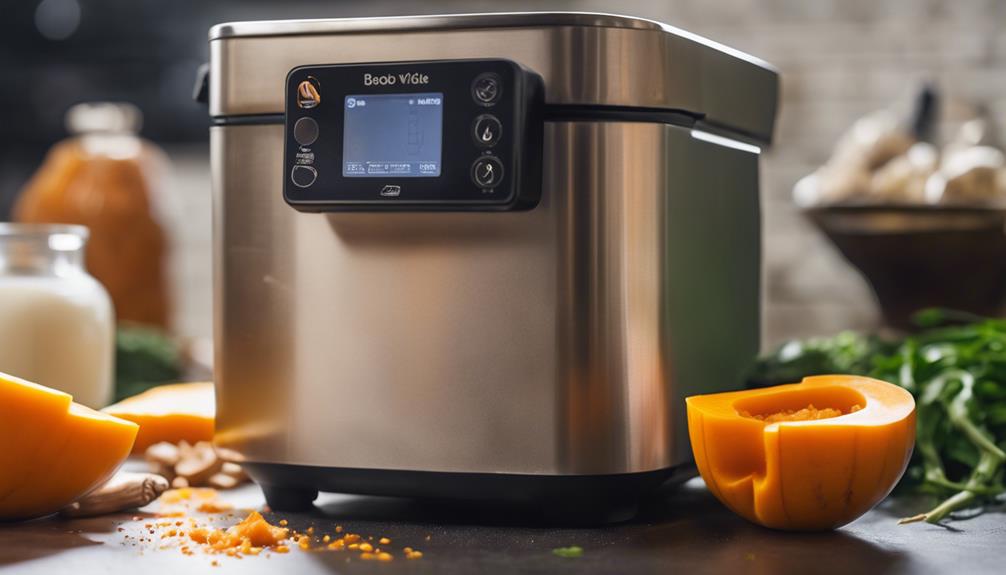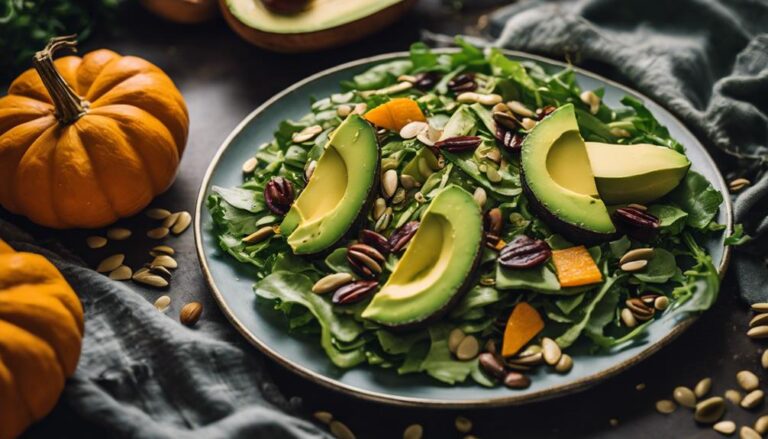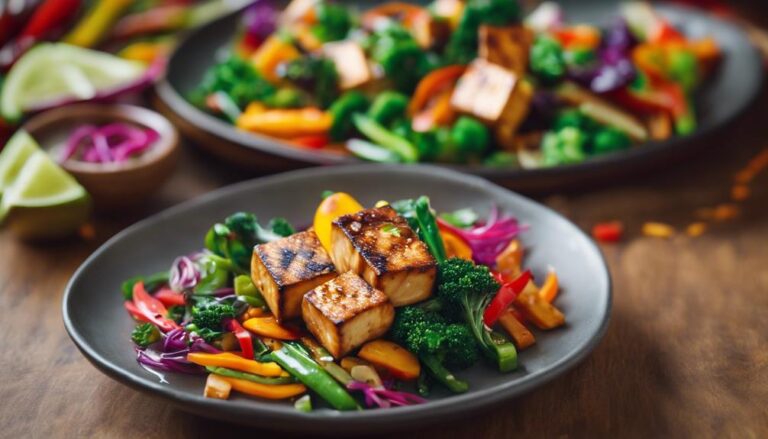Soup Sous Vide Butternut Squash Soup for the Nourish and Glow Diet
Enhance your Nourish and Glow Diet with velvety smooth sous vide butternut squash soup. Butternut squash, onions, and garlic create a rich flavor base, while thyme or sage adds earthy notes. The sous vide technique guarantees precise temperature control for uniform cooking, preserving natural flavors. Vacuum-sealing locks in aromas, resulting in a flavorful and textured soup. Explore variations like Butternut Squash Bisque for unique twists. Sous vide cooking offers consistent heating for harmonious flavor development. Elevate your dining experience with nutrient-packed ingredients and rich flavors in a nourishing bowl of soup.
What You Will Learn Here
- Sous vide butternut squash soup retains nutrients for a nourishing meal.
- Precise cooking ensures rich flavors and a velvety texture.
- Perfect for the "Nourish and Glow" diet with balanced nutrition.
- Sous vide technique enhances taste, ideal for a healthy eating plan.
- Enjoy a flavorful, nutrient-packed soup with sous vide-cooked butternut squash.
Soup's Evolution Over Time
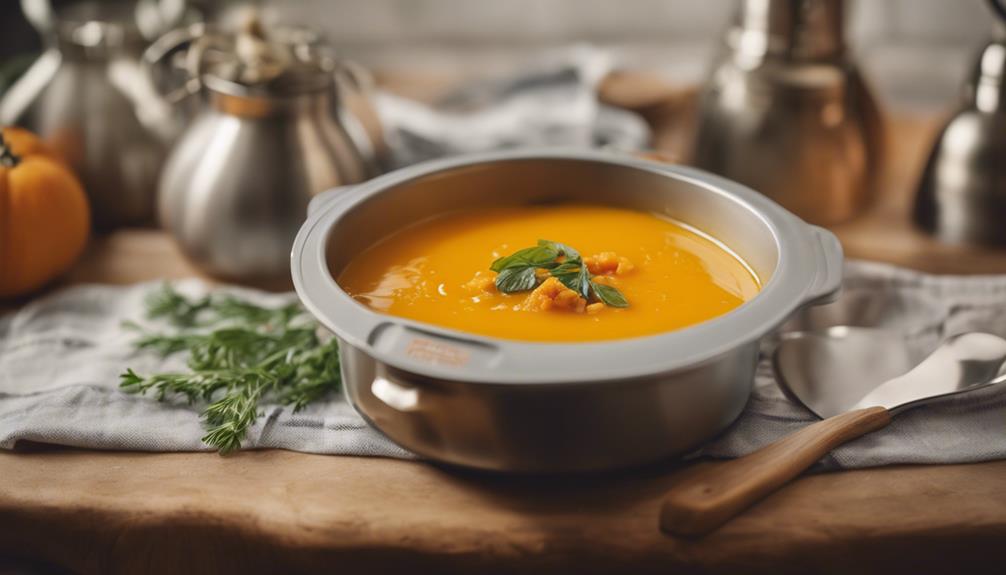
Soup has a rich history, with origins dating back centuries.
From simple broths to complex bisques, soup has evolved to encompass a wide array of flavors and ingredients.
Understanding these historical roots can provide insight into modern soup trends and the nutritional benefits they offer.
Historical Soup Origins
As culinary traditions evolved over centuries, soups underwent a fascinating transformation, adapting to the changing tastes and ingredients available throughout different historical periods. Soup origins can be traced back to ancient civilizations like the Greeks and Romans, who enjoyed various broth-based dishes.
Cultural influences played a significant role in shaping historical soup recipes, with each region adding its own unique spices and ingredients to create distinct flavors. In medieval Europe, soups were often thickened with bread or grains due to ingredient availability. The use of vegetables, herbs, and meats depended on what was locally grown and accessible during that time.
As trade routes expanded, new ingredients like spices and exotic vegetables made their way into soup recipes, enriching the culinary landscape. During the Renaissance, elaborate soups became a symbol of wealth and status, with rich broths and intricate flavor combinations gracing the tables of nobility.
The evolution of soups over time showcases how these humble dishes have been influenced by culture, history, and the availability of ingredients.
Modern Soup Trends
Culinary trends have continued to shape the evolution of soups, reflecting changing tastes and ingredient availability over time. In the modern era, soup presentation has become a focal point, with chefs exploring creative ways to elevate the visual appeal of this comforting dish. From intricate swirls to artistic drizzles, how a soup looks on the plate is now just as important as how it tastes.
Soup garnishes have also seen a transformation in recent years. What was once a simple sprinkle of herbs has evolved into a wide array of options, including crunchy croutons, creamy swirls of yogurt, or even delicate edible flowers. These garnishes not only add texture and flavor but also offer a hint of sophistication to even the humblest of soups.
As culinary boundaries continue to expand, the future of soups looks promising, with chefs pushing the limits of creativity in both presentation and garnishes to offer diners a multisensory experience that goes beyond mere sustenance.
Nutritional Benefits Explained
Exploring the nutritional benefits of soups reveals how their evolution over time has contributed to enhancing the overall health value of this comforting dish. Soups have come a long way from simple broths to nutrient-packed meals. The health benefits of soups lie in their nutrient profile, often containing a rich combination of vitamins, minerals, and antioxidants.
As soups evolved, so did their nutrient content, with ingredients like butternut squash adding a dose of vitamin A and fiber to nourish your body.
The nutrient profile of soups can vary depending on the ingredients used, but many soups offer a balanced mix of carbohydrates, proteins, and healthy fats. This balance contributes to sustained energy levels and overall well-being.
By incorporating a variety of vegetables, proteins, and whole grains, soups have become a go-to option for those looking to improve their diet without sacrificing flavor.
Key Soup Ingredients
You'll need several key ingredients to make this delicious butternut squash soup recipe. Here are the essential components that will bring out the rich flavor profiles in your soup:
- Butternut Squash: The star of the show, this ingredient adds a sweet and nutty flavor to the soup.
- Onion: Provides a savory undertone and enhances the depth of the soup's taste.
- Garlic: Adds a robust and aromatic element, complementing the sweetness of the squash.
- Vegetable Broth: Serves as the base of the soup, infusing it with a savory and umami richness.
- Herbs (such as thyme or sage): These herbs contribute earthy notes and a subtle hint of freshness to the overall flavor profile.
Trending Butternut Squash Soup Variations
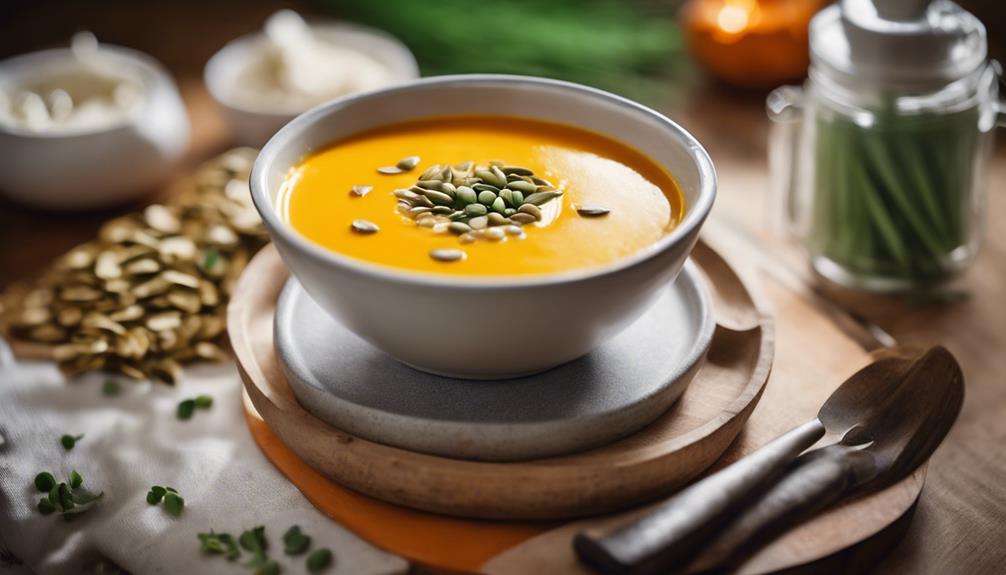
Discover exciting variations of butternut squash soup with these trending recipes:
Butternut Squash Bisque, a velvety smooth version perfect for cozy evenings;
Vegan Butternut Squash Soup, a dairy-free alternative bursting with flavors of roasted squash;
Creamy Butternut Squash Soup, a rich and indulgent twist on the classic recipe.
Each variation offers a unique take on this beloved fall favorite, allowing you to explore new culinary horizons while savoring the comforting essence of butternut squash.
Try them all to find your perfect bowl of warmth and deliciousness.
Butternut Squash Bisque Recipe
Consider trying a velvety and flavorful Butternut Squash Bisque to elevate your soup game with a touch of sophistication and richness. This luxurious soup is perfect for fall, combining seasonal ingredients to create a dish bursting with warm flavors and creamy texture.
Here are some tips to enhance your Butternut Squash Bisque experience:
- Roasted Butternut Squash: Roasting the squash intensifies its natural sweetness and adds depth to the soup.
- Warm Spices: Incorporate cinnamon, nutmeg, or a hint of cayenne for a complex flavor profile.
- Coconut Milk: Use coconut milk for a dairy-free option that adds a luscious creaminess to the bisque.
- Toasted Pumpkin Seeds: Top your bisque with toasted pumpkin seeds for a crunchy texture contrast.
- Fresh Herbs: Garnish with a sprinkle of fresh herbs like parsley or chives for a pop of color and freshness.
For an elegant presentation, consider serving the bisque in individual soup bowls garnished with a swirl of coconut milk, a sprinkle of toasted pumpkin seeds, and a sprig of fresh herbs.
Vegan Butternut Squash Soup Recipe
Try this flavorful and creamy Vegan Butternut Squash Soup recipe to experience a trendy twist on a classic favorite. This vegan version of butternut squash soup is perfect for those looking for a plant-based option that doesn't compromise on taste. Utilizing seasonal ingredients, this soup isn't only delicious but also a great way to enjoy the flavors of fall.
When serving this dish, presentation is key to impress your guests or simply elevate your dining experience.
- Seasonal Ingredients: Incorporate fresh butternut squash, onions, garlic, and vegetable broth for a soup that captures the essence of autumn.
- Flavor Profiles: The soup boasts a rich and velvety texture with a hint of sweetness from the butternut squash, complemented by savory undertones from the onions and garlic.
- Garnish Options: Top your soup with a drizzle of coconut cream, a sprinkle of roasted pumpkin seeds, or a dash of smoked paprika for added depth of flavor.
- Nutritional Benefits: This soup isn't only delicious but also packed with vitamins and minerals, making it a nourishing choice for any meal.
- Presentation: Serve in a rustic bread bowl or elegant soup tureen for a visually appealing presentation that enhances the dining experience.
Creamy Butternut Squash Soup Recipe
For a modern twist on the classic butternut squash soup, consider trying a velvety smooth variation that incorporates unexpected flavors. To create a creamy butternut squash soup, start with the traditional base and infuse it with seasonal ingredients to elevate its taste and nutritional value.
Here are some tips to enhance your soup:
- Use Fresh Herbs: Add a pop of freshness by garnishing with chopped sage or thyme.
- Experiment with Spices: Try incorporating cinnamon or nutmeg for a warm and cozy flavor profile.
- Creamy Coconut Milk: Substitute traditional cream with coconut milk for a dairy-free option.
- Roasted Garlic: Roast garlic cloves and blend them into the soup for a rich, earthy undertone.
- Crunchy Toasted Pumpkin Seeds: Top your soup with toasted pumpkin seeds for a delightful crunch and added texture.
These flavor variations and garnish options won't only enhance the soup's taste but also provide a visually appealing touch to your dish.
Sous Vide Technique
When utilizing the sous vide technique for your butternut squash soup, you can achieve precise temperature control throughout the cooking process.
This method guarantees even distribution of heat, allowing the squash to cook uniformly.
Additionally, the sous vide technique helps preserve the natural flavors of the ingredients, resulting in a rich and flavorful soup.
Precise Temperature Control
Achieve precise temperature control with the sous vide technique by setting the water bath to the desired temperature. This method offers unparalleled temperature precision, unlike many traditional cooking techniques.
By cooking your ingredients in a precisely controlled water bath, you guarantee that your butternut squash soup receives consistent heat throughout the cooking process, resulting in a perfectly cooked dish.
Moreover, sous vide allows for best flavor infusion and texture control. The vacuum-sealed bags lock in flavors and aromas, preventing any loss during cooking. This means that your butternut squash soup will be infused with all the delicious flavors you've included.
Additionally, the gentle cooking process maintains the ingredients' textures, ensuring that your soup is velvety smooth and packed with the right amount of bite.
With precise temperature control, sous vide elevates your cooking experience, enabling you to create a butternut squash soup that isn't only delicious but also perfectly cooked every time.
Even Cooking Distribution
Guarantee consistent and uniform cooking throughout your butternut squash soup by utilizing the sous vide technique for even cooking distribution. When you cook your soup sous vide, you guarantee that the temperature remains constant, distributing heat evenly to every part of the butternut squash mixture. This precise control over the cooking environment leads to a perfectly cooked soup with no hot spots or undercooked areas. The even temperature maintained during the sous vide process allows the flavors to develop harmoniously as the ingredients cook uniformly.
The sous vide method offers a foolproof way to achieve consistent cooking results every time you make butternut squash soup. By vacuum-sealing your ingredients in a bag and cooking them in a water bath at a controlled temperature, you eliminate the risk of overcooking or unevenly cooked components. This technique ensures that your soup will turn out just right, with all the flavors melding together seamlessly for a delicious and satisfying dish.
Retains Natural Flavors
Maintain the authentic and vibrant flavors of your butternut squash soup by employing the sous vide technique, preserving the essence of each ingredient for a truly delightful dining experience.
When using sous vide for your soup, you guarantee flavor enhancement through slow cooking, allowing the ingredients to meld together harmoniously. This method involves sealing the butternut squash, spices, and other components in an airtight bag and cooking them in a precisely controlled water bath for an extended period.
By cooking at lower temperatures for a longer time, sous vide benefits the soup by retaining the natural flavors that might otherwise be lost through traditional cooking methods. Additionally, this gentle cooking process aids in nutrient retention, ensuring that your butternut squash soup isn't only flavorful but also nutritious.
Embrace the sous vide technique to elevate your soup game and savor every spoonful of goodness.
Final Thoughts
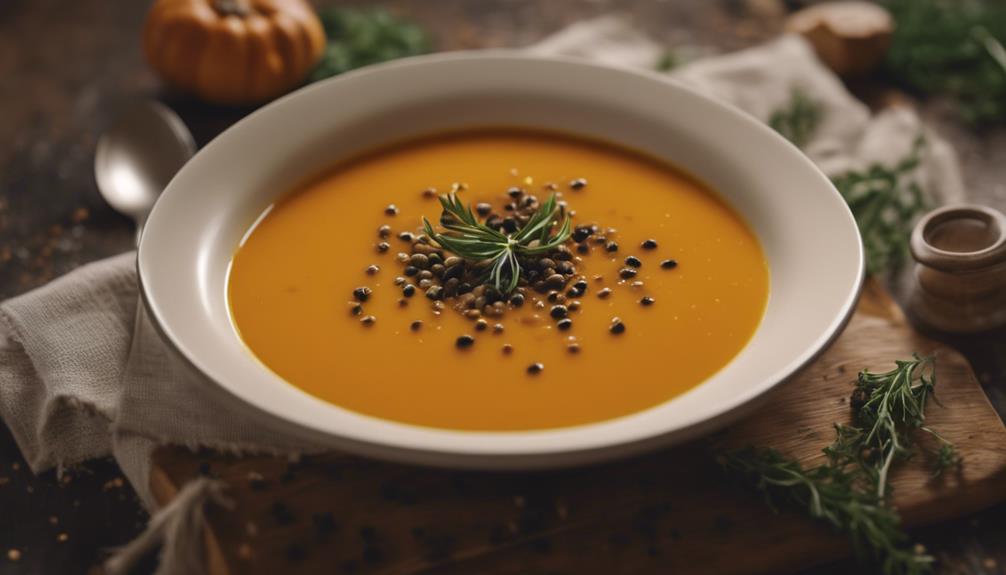
As you reflect on the delicious flavors and comforting warmth of this butternut squash soup recipe, consider how easily it can become a staple in your fall menu rotation.
Embracing a healthy lifestyle is made simpler with dishes like this, packed with nutrients and flavor. By utilizing sous vide culinary techniques, you lock in the natural goodness of the ingredients, ensuring a nourishing meal every time.
This soup not only satisfies your taste buds but also provides a boost of vitamins and minerals essential for your well-being.
Incorporating such recipes into your regular meal planning can elevate your culinary skills while promoting a balanced diet.
The simplicity of this soup makes it a convenient option for busy days, allowing you to nourish your body without sacrificing taste or health benefits.
Frequently Asked Questions
Can I Use a Regular Blender Instead of an Immersion Blender?
You can use a regular blender instead of an immersion blender for smoother soup texture. Both blender options work well, but be careful with hot liquids in a regular blender to prevent spills and potential burns.
Can I Substitute Butternut Squash With Other Vegetables?
Yes, you can substitute butternut squash with other vegetables for flavor variations in your soup. Consider using sweet potatoes, carrots, or pumpkin. Each vegetable offers unique nutritional benefits and can be cooked using similar techniques for a delicious dish.
How Can I Adjust the Consistency of the Soup to My Liking?
To adjust the consistency of your soup, blend longer for a smoother texture or add a splash of broth to thin it out. Enhance flavor by seasoning with herbs or spices. Experiment with ingredient substitutions and try roasting vegetables for added depth.
Is It Necessary to Peel the Butternut Squash Before Cooking?
When it comes to the peeling debate of butternut squash, it's not necessary. You can leave the skin on for added nutritional benefits. Enjoy the ease and extra nutrients that come with keeping it on.
Can I Freeze the Soup for Later Consumption?
Yes, you can freeze the soup for later consumption. To freeze, make sure it's completely cooled, then store in airtight containers. For reheating, thaw overnight in the fridge or heat directly from frozen. Enhance flavors with a sprinkle of fresh herbs and serve with crusty bread.
Conclusion
To sum up, sous vide butternut squash soup offers a delicious and nutritious option for those looking to nourish and glow. By using the sous vide technique, the flavors of the ingredients are intensified, creating a velvety texture and rich taste.
With the right combination of key ingredients and trending variations, this soup is a satisfying and healthy addition to any diet. So why not give it a try and enjoy a bowl of warm, comforting soup that will leave you feeling nourished and satisfied.
